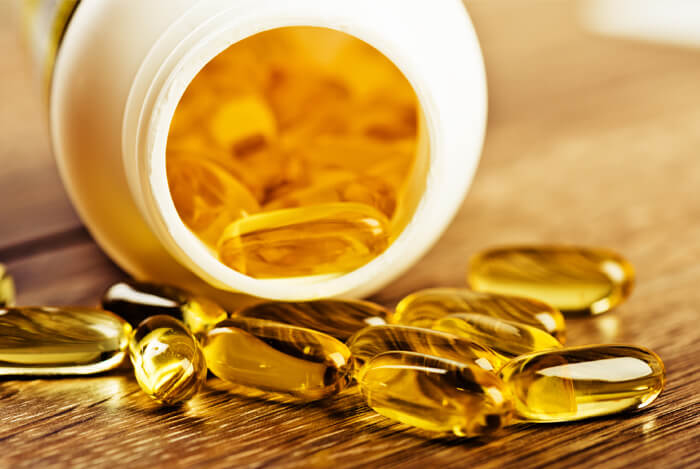It’s a bright and sunny day outside, and you’re feeling on top of the world. You’re in a great mood, and you can’t wait to take advantage of everything the day has to offer.
What you probably didn’t realize is whether you’re outside swimming, laying out, just relaxing, gardening or whatever it is that you enjoy doing outside, you’re actually in taking a vitamin – vitamin D that is.
And not only are you taking in an important nutrient, this vitamin could even be playing a role in that happy mood you’re experiencing.
Want to know more? Here’s everything you need to know about this powerful “sunshine” vitamin:
- Meet Vitamin D
- The Purpose Behind Vitamin D
- How Much Do You Need?
- What Happens if You Don't Get Enough or Get Too Much?
- Who Should Take Vitamin D Supplements?
- The Final Word on Vitamin D
Table of Contents
+Meet Vitamin D

You can find vitamin D in a few foods naturally, such as tuna fish, swordfish and salmon. It’s also present in beef liver, eggs and cheese. Because of the lack of vitamin D in many people’s diets, some foods have it added in, such as yogurt, milk, orange juice and certain cereals.
Spending time outside in the sun will also give you vitamin D, but not because it actually comes from the sun. Instead, the sun’s ultraviolet rays hit the skin and cause vitamin D synthesis to occur.
The concern of skin cancer is a huge factor in why some people aren’t obtaining enough vitamin D, as people either minimize their time outdoors or cover their skin with clothing or sunblock.
But although the sunscreen will help reduce a person’s risk of skin cancer, it also harms your ability to obtain vitamin D. Even sunscreens with an SPF of 8 lessen a person’s ability to produce the vitamin by 95 percent!
That’s why you need to get it from other sources.
But no matter how you obtain this nutrient, it has to undergo two different – yet equally-important – processes in the body.
First, it must convert into calcidiol in the liver. Then, it undergoes a process in the kidneys that changes it into calcitriol, also known as 1,25-dihydroxyvitamin D. These steps are both necessary to transform the vitamin D you take in into a form your body can actually use.
Unlike vitamins C and E that are expelled as a waste product from the body when they’re in excess, extra vitamin D remains in the body and is stored for later use. It’s a fat-soluble vitamin that’s able to be stored in fatty tissue and in the liver, which your body can use when your D levels are low.
At the end of the day, how much vitamin D your skin makes depends on various factors, such as the time of year, the time of day, the season, your skin pigmentation and your location.
The Purpose Behind Vitamin D

One of the biggest reasons people need vitamin D is for skeletal and dental health, where it regulates the amount of phosphate and calcium in your body – both of which are necessary for your bones to develop and repair themselves.
Without a combination of calcium and vitamin D, bones aren’t as strong as they could be. As a result, they may become fragile and brittle, and may break easily – even without a serious injury occurring.
Vitamin D has other benefits as well, such as the role it plays in the nervous system, where it regulates the development and function of the nerves. It has a neuroprotective effect due to the fact that it has an influence on neurotrophin production and release.
Additionally, it has an impact on neuromediator synthesis and may even protect the cells from tissue damage that arises from oxidative damage.
I later researched and discovered these are a big concern for people who are lacking vitamin D. The vitamin has the ability to help prevent brain disorders like dementia. I’m glad I got back on track taking my supplements before things got too serious!
But that isn’t all that vitamin D can do for you. This nutrient is vital for the body in a number of other ways.
For instance, without vitamin D, you won’t be able to move freely or normally because your muscles require it. Your nerves need it to transmit messages from your brain to other parts of your body. As a result, vitamin D plays a role in your movements and how your body responds.
How Much Do You Need?

Not sure if you’re getting enough vitamin D? Want to avoid some of the negative side effects I experienced when my levels were low?
Then you need to get your levels tested!
If you think you’re not getting enough vitamin D or have symptoms of a deficiency, ask your physician for a 25(OH)D test. Although there’s also the 1,25(OH)₂D test, it won’t tell you if you have a deficiency or not.
The test is a blood test that can be obtained by pricking your finger. You can ask your physician to give you the test, or you can purchase a test to do at home. Then, as you interpret your results, know that different governing health organizations advise for different levels.
For instance, the Vitamin D Council suggests your level be around 50 ng/ml. Ultimately, you want the reading to be between 40 and 60 nmol/L. Levels that are less than 30nmol/L aren’t high enough to support good bone health, let alone your general health. Having a reading above 125 isn’t healthy either.
To obtain optimal levels, you need to meet the following requirements:
- Infants between the ages of zero to 12 months should get 400 IU per day.
- Children above the age of one-year-old need 600 IU daily, as do adults who are under the age of 70. Those who are over 70 require 200 additional IU per day, as their skin doesn’t convert sunlight to vitamin D as effectively as someone who is their 30s or 40s.
- Breastfeeding mothers need the same amount as an adult or teen who isn’t nursing a little one. The same applies to pregnant women.
Sounds pretty simple, right? That’s because it is!
If you can’t get all the vitamin D you need from sunlight alone, supplementing to meet these levels is an incredibly easy way to maintain your health.
What Happens if You Don’t Get Enough or Get Too Much?

The number of people who have inadequate D levels is rising, despite all the foods fortified with it. I know – I’m part of this statistic.
People don’t get enough either because they don’t consume enough or because they don’t go out in the sun enough. In some (rarer) cases, a person might be unable to convert vitamin D into its active form because of kidney problems.
Children who don’t get enough vitamin D may develop a condition known as rickets. As previously mentioned, people – including children – require vitamin D to maintain a correct balance of phosphorus and calcium. When they experience an extreme and prolonged deficiency, rickets occurs and leads to the bones softening and weakening in children.
Eating items containing vitamin D or taking supplements tends to correct the problem and will fix any bones problems that arose from the rickets. However, children who have a genetic condition that led to rickets may need medications and treatment. The skeletal deformities that are attributed to soft bones not forming correctly may require surgical correction and are most common in infants and children of African American descent.
Adults who develop a deficiency may wind up with a condition known as osteomalacia that leaves bones were soft and very bendable. Unlike osteoporosis, which causes weakening in previously constructed bone, osteomalacia causes issues with the bone-building process, leading to muscle weakness and achy bone pain.
Treatment for osteomalacia involves replenishing low levels of vitamin D and calcium and treating any underlying disorders that may be causing the deficiencies.
I know that sounds pretty scary, so I wouldn’t blame you if you were thinking about doubling up on your vitamin D supplement. But before you reach for an extra dose, be aware that more vitamin D isn’t necessarily better.
In fact, taking more vitamin D than needed through supplementation can cause health problems in the future. On the contrary, it’s not possible to overdose on vitamin D made from the sun, or from foods that don’t contain high quantities of it.
Although rare, hypervitaminosis D – also known as vitamin D toxicity – is possible and may be serious. Generally, it’s caused by taking large doses of supplements containing vitamin D.
People who experience vitamin D toxicity tend to end up with a large quantity of calcium in the blood – a condition referred to as hypercalcemia. Symptoms of hypercalcemia can include nausea, vomiting, poor appetite, frequent urination, kidney problems and weakness.
The first step to recovering from an overdose of vitamin D – whether it developed over time or suddenly – is to reduce the amount of vitamin D a person takes in. This can be done with intravenous fluids or medications like bisphoshonates or corticosteroids.
Those who have kidney or liver conditions are at greater risk, and so are people who take thiazide-type diuretics. People who take 50,000 international units, abbreviated IU, over the course of several months are the ones who are at risk of toxicity. Anyone who takes more than 600 IU per day should have their blood levels regularly monitored.
Who Should Take Vitamin D Supplements?

Beyond the general recommendations I shared above, there are certain groups of people who should be doubly-certain to take supplements to ensure they’re getting enough vitamin D.
One example is people who have Crohn’s or celiac disease. Both conditions cause people to improperly absorb carbs, fats and proteins. Vitamin D requires fat to absorb, thereby causing the malabsorption of vitamin D – ultimately resulting in a vitamin deficiency. Not to mention, people who have these conditions will typically have a calcium deficiency as well, which causes further bone issues.
Those with dark skin have a decreased ability to obtain vitamin D from sun exposure, while those who fall into the category of obese experience problems with vitamin D absorption as well. This occurs because the excess body fat binds to a portion of the vitamin D and stops it from reaching the bloodstream.
Finally, breastfed infants may benefit from a supplement because human milk doesn’t contain a large amount of vitamin D. Infants who drink less than 500 ml of formula each day may benefit from a supplement as well. Continue with the vitamin until the child reaches at least five years of age, or at your doctor’s recommendation.
The Final Word on Vitamin D

One thing you need to know is that the recommended amount of vitamin D a person should get has been debated in recent years.
The Institute of Medicine released a report on November 30, 2010 that recommended both adults and children need more than three times the amount of vitamin D that was currently recommended, which led to U.S. and Canada suggesting people get at least 600 IU per day. The safety limits were pushed from 2,000 IU per day to 4,000 per day.
Other new research suggests that Vitamin D may help to ward off certain medical conditions, such as diabetes, some cancers, heart disease and various autoimmune disorders. The heart muscle relies on potassium every time it beats, but scientific evidence is showing vitamin D might be beneficial to the heart, too.
In this particular study, the Health Professional Follow-Up Study, scientists followed almost 50,000 men’s vitamin blood levels for 10 years and found that the men who had a vitamin D deficiency were twice as likely as men who had normal vitamin D levels to have a heart attack.
Other studies conducted revealed low levels of vitamin D increased a person’s risk of sudden cardiac death, stroke, cardiovascular disease, heart failure and cardiac death, according to Harvard University. Evidence points to this vitamin playing a role in blood pressure regulation as well as artery damage, but more research is needed to prove this.
One 30-year study followed 10,000 Finnish kids from birth. The children who took a vitamin D supplement during infancy had a 90-percent lower risk of type I diabetes than the ones who didn’t get a supplement. Multiple other studies conducted in Europe showed that vitamin D may protect against diabetes, but only juvenile diabetes.
Vitamin D may even play a role in preventing the development of a cold or the flu. Typically, people get a cold or a flu in the winter, but one British doctor hypothesized that this may be because vitamin D levels are lowest in the winter. Plus, vitamin D boosts immune cells’ production of the proteins that fight microbes.
If you ask me, that’s all pretty amazing!
My own experiences dealing with vitamin D have shown me how important this “sunshine” vitamin is to good health, and I hope that these studies are enough to convince you to make supplementation a part of your regular routine.










